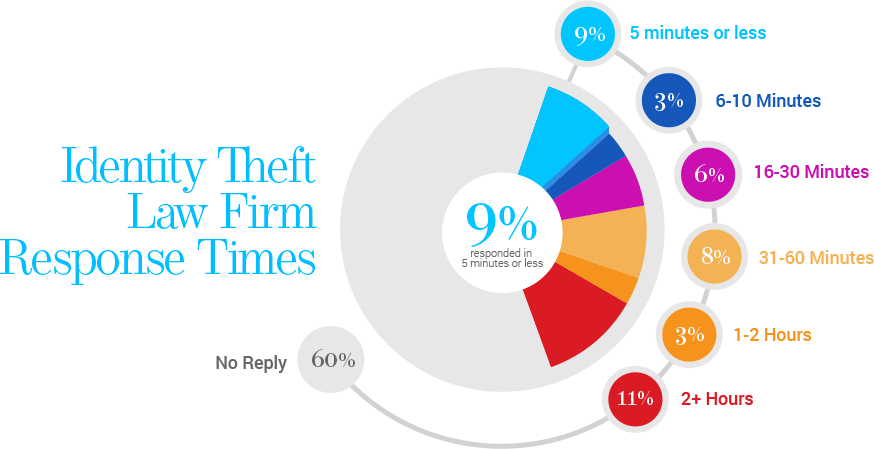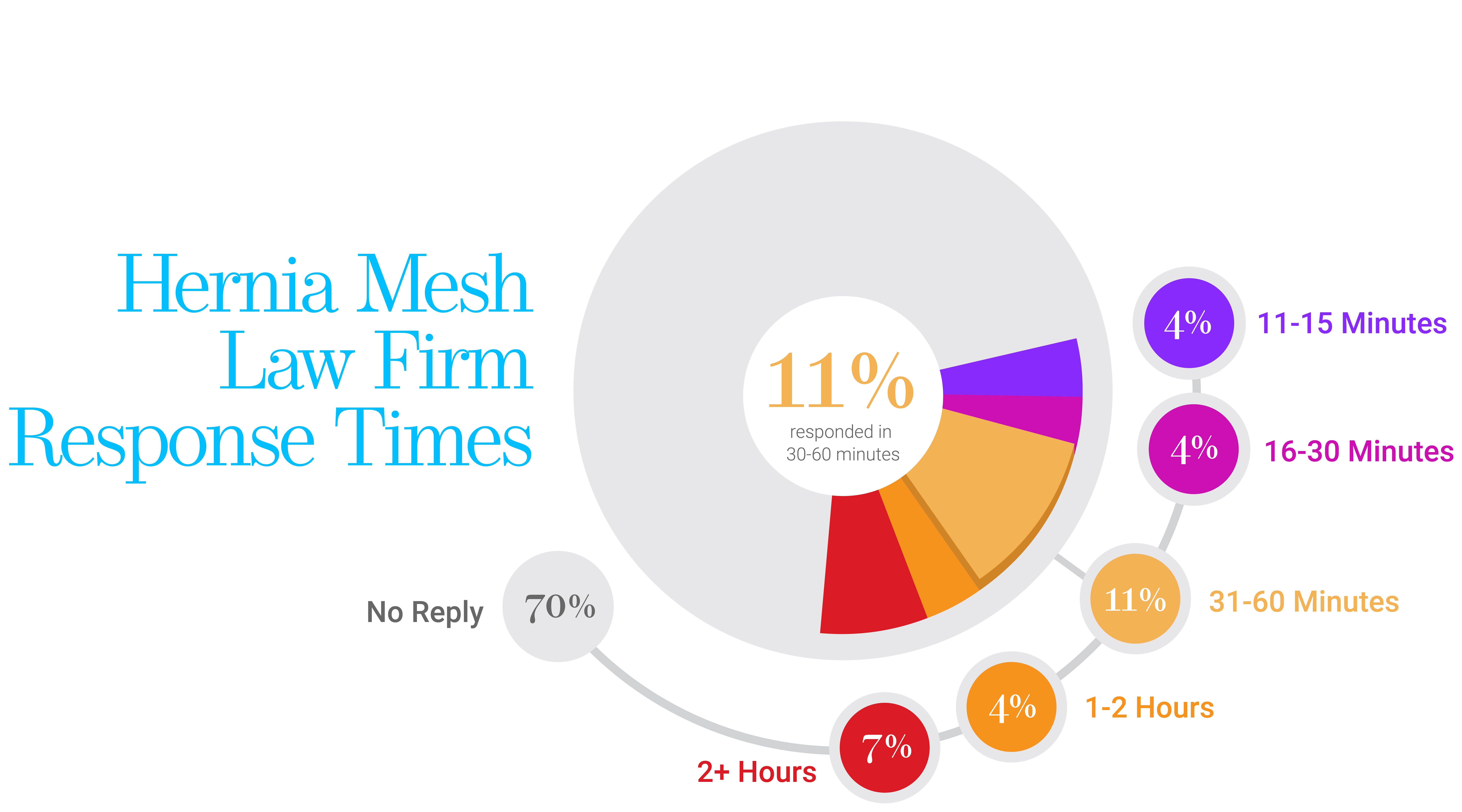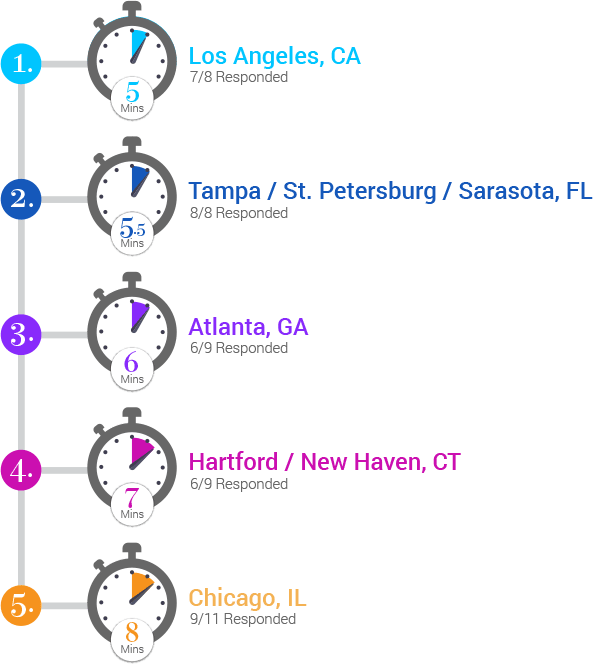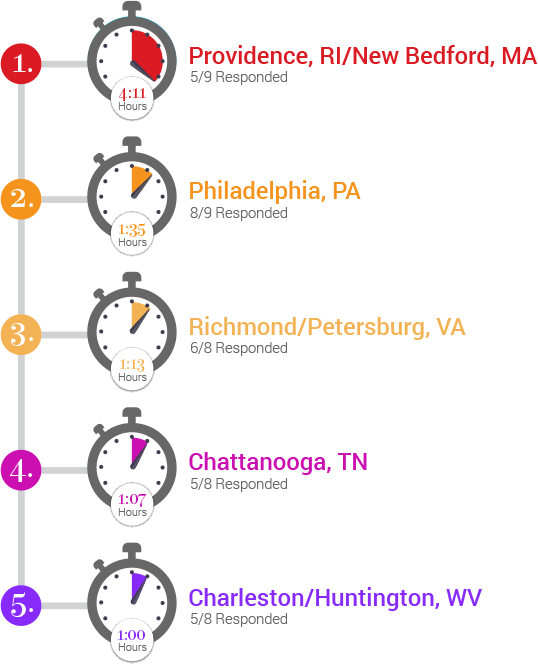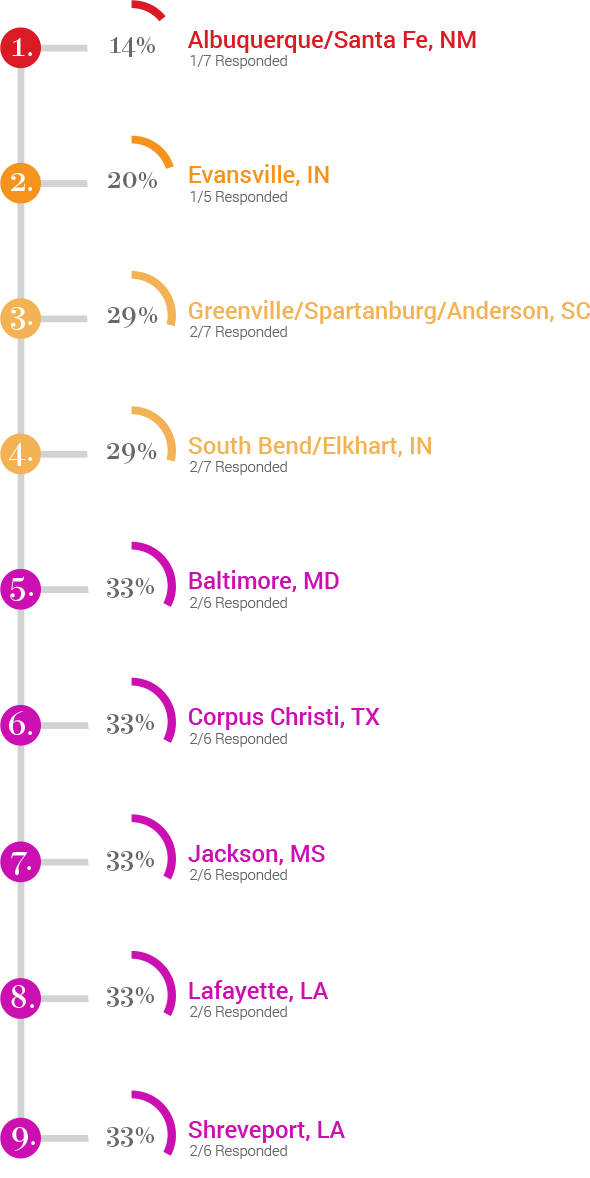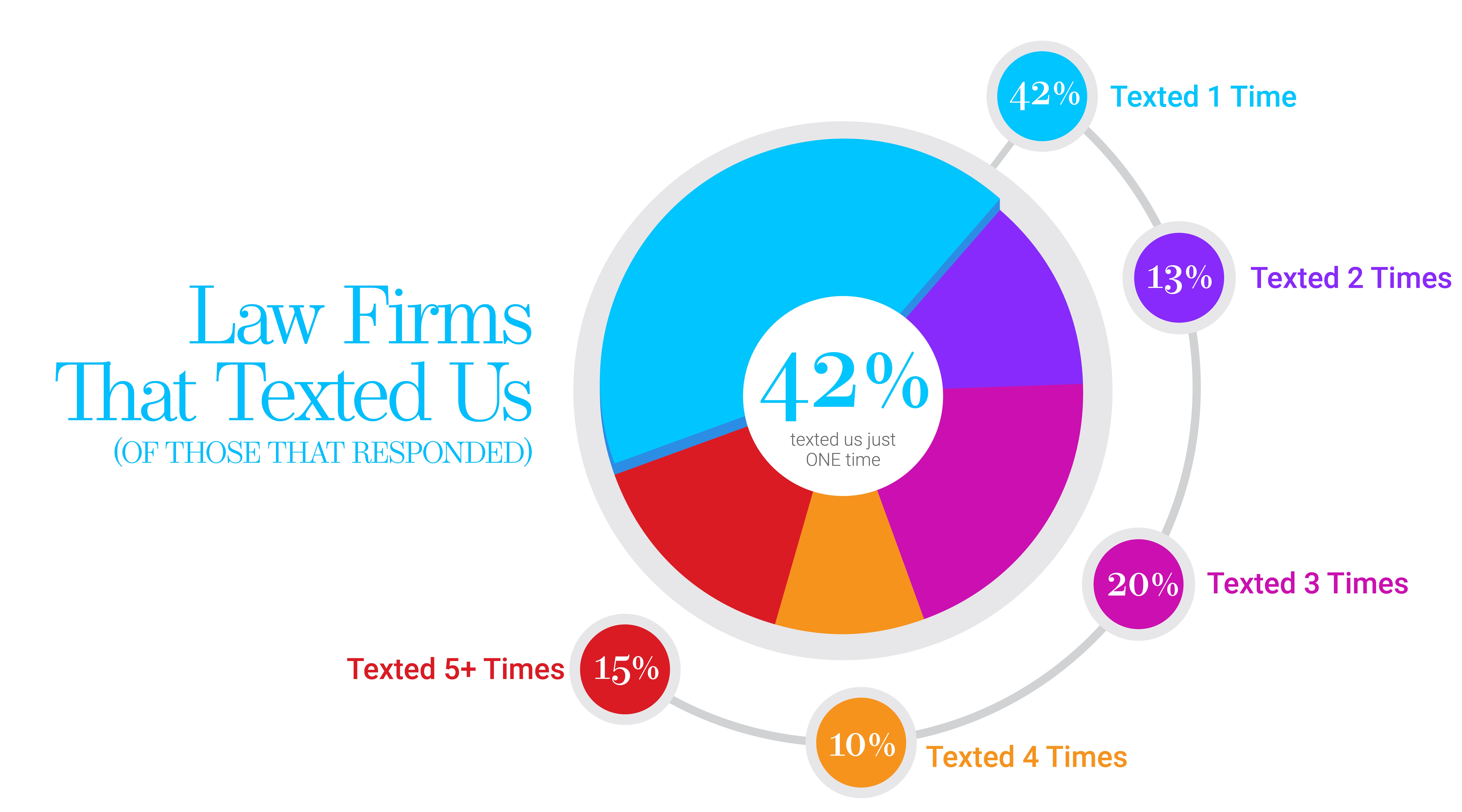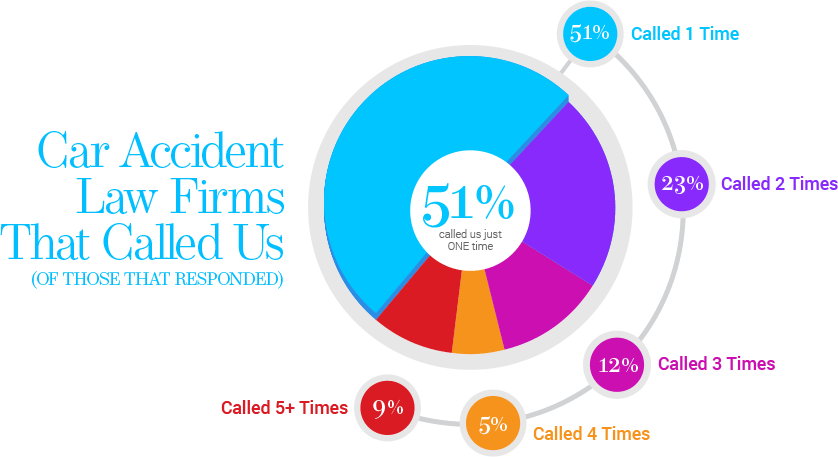Thank You To Our Sponsor
Alert Communications.
Quality leads are the lifeblood of any successful law firm’s marketing strategy. Some firms move aggressively to respond quickly to potential clients, but a shocking number of firms don’t move fast enough—or respond at all!
Hennessey Digital performed a comprehensive survey of more than 700 top law firms in the U.S. to learn more about potential client user experience and develop a list of best practices for lead form response. (For a more recent version, see our 2022 study!)
Law Firm Responsiveness Report Card
Response Times by City
- 1. Los Angeles 5 mins
- 2. Tampa / St. Petersburg 5.5 mins
- 3. Atlanta 6 mins
- 4. Hartford / New Haven 7 mins
- 5. Chicago 8 mins
- 1. Providence / New Bedford 4:11 hrs
- 2. Philadelphia 1:35 hrs
- 3. Richmond/Petersburg 1:13 hrs
- 4. Chattanooga 1:07 hrs
- 5. Charleston/Huntington 1:00 hrs
Median Response Times by Case Type
- Car Accidents 19 mins
- Identity Theft 40 mins
- Hernia Mesh 55 mins
Opportunity
Cheers to the 59% of law firms in our study that responded to lead forms. Should the 41% that didn’t be worried?
Key Takeaways (TL;DR)
“Is anybody out there?” We reached out to 701 of the top law firms across the U.S. 59.3% responded to our lead form submissions, and 40.7% of law firms didn’t respond at all.
You’ve got to act fast. If you take away any key metric from this study, it’s this: 70% of firms that responded to our inquiry did so within an hour, and 59% responded within 30 minutes.
The competition is fierce. In hyper-competitive legal markets, failing to respond to lead form inquiries within 30 minutes means you’re giving clients away to your competitors.
Methodology
We contacted law firms that appear on multiple Top Law Firm lists, including those that categorize their overall marketing spend:
As a control, we submitted all lead form inquiries between the hours of 10 a.m. and 12 p.m. in law firms’ local time zones. We tracked response times up to seven days after we submitted our information: past that point, we considered firms ‘unresponsive.’ We submitted all lead form inquiries through the law firm’s official website.
Our goal was to see how long on average it took for law firms to respond to lead form submissions. After seven days, we broke down the data to analyze trends and characteristics that the fastest-responding firms shared.
Curious if we contacted your
law firm for this study?
Contact [email protected] and we’ll let you know!
Want to be included in future studies?
What We Said in Lead Form Submissions
Using the alias “Lizabeth Kennedy” born in 1978, we designed several stories to elicit a response from law firms as a legitimate potential lead. Those stories changed when targeting different practice areas:
Car Accident (588 firms contacted)
“I was at a stoplight and was rear-ended into the intersection and into oncoming traffic. My car was totaled and I was hospitalized with neck injuries.”
Construction Injury (5 firms contacted)
“I was walking by a construction site and materials fell on top of me and my dog. I lost my dog and am being treated for injuries to the neck and brain.”
Identity Theft (35 firms contacted)
“I was a victim of identity theft and multiple banking institutions are trying to collect a debt that I never spent. This is crazy. Please help.”
Hernia Mesh (27 firms contacted)
“I received a hernia mesh implant and have been suffering serious pain ever since. I am afraid the implant was defective. Please help!”
What We Discovered
Looking at the data, the first thing we noticed is how many firms never got back to us. Only 59.3% of firms responded to our lead form submissions at all, so over 40% of law firms we contacted left a potential lead on the table.
It’s important to note here that websites aren’t always foolproof: we got multiple error messages from broken lead forms on firms’ sites we tested. Monitor and test your website’s lead form to make sure it works properly—don’t miss out on leads due to a technology breakdown!
Now let’s drill into the data to see firms’ response rates and times by city and case type.
Fastest-Responding Firms By Case Type
The vast majority of law firms we contacted were personal injury firms. We gave 614 total firms our car accident story: 64% of those responded to our inquiry and 36% never contacted us. Overall, the firms that did get back to us were fast—of all the firms we contacted, 23% responded within 10 minutes. On the slower end, 13% of firms took more than two hours to contact us.
The median response time for car accident cases was 19 minutes. If you’re a firm that wants to be competitive in this market, keep in mind that your typical competitor contacts their leads in less than 20 minutes.
The other two fastest-responding practice areas were identity theft and hernia mesh. When we reached out to 35 law firms with our identity theft story, only 40% responded. 21% of responding firms got back to us within 5 minutes, and 71% responded within 2 hours. The median response time for identity theft cases was 40 minutes.
For hernia mesh cases, we contacted 27 firms. Incredibly, only 30% of those firms even responded to our inquiry. Of those that responded, 25% did so within 30 minutes, and 75% did within two hours. The median response time for hernia mesh cases was just under an hour at 54.5 minutes.
Of firms that responded to our lead form inquiry, we found that:
- 59% responded within 30 minutes
- 70% responded within an hour; and
- 79% responded in two hours or less.
Across all case types, 70% of law firms responded within one hour.
Of all the law firms we contacted for this study,
145 firms responded within 10 minutes.
Congrats to those who were quick on the draw! Did your firm make the cut?
- Mike Hostilo Law Firm
- Glasheen, Valles & Inderman, LLP
- The Joel Bieber Firm
- Jonathan Perkins Injury Lawyers
- The Law Offices of Jacob Emrani
- The Paul Wilkinson Law Firm, LLC
- Castle Law Office
- Hoffman Law Firm, LLC
- Kelleher Law
- Joye Law Firm
- Alexander & Associates
- Golightly & Associates
- The Dominguez Firm
- Floyd Hunter Injury Law
- Heuser & Heuser, LLP
- Hoglund Law
- Golitko & Daly, P.C.
- Martin Law Firm, P.L.
- Russ Brown Motorcycle Attorneys
- The Law Offices of Blaine Barrilleaux
- Breyer Law Offices
- The Law Offices of Blake R. Maislin, LLC
- Colombo Law
- DebtStoppers Bankruptcy Law Firm
- Deputy & Mizell, LLC
- Law Offices of James Scott Farrin
- The Frickey Law Firm
- Law Offices of Kenneth Hiller, PLLC
- The Law Offices of Larry H. Parker Inc.
- Hardison & Cochran, Attorneys at Law
- Law Offices of Mark E. Salomone
- Smith & Hassler, Attorneys at Law
- Terry Bryant Accident & Injury Law
- Winters & Yonker, P.A.
- Bottaro Law Firm
- Carter Mario Law Firm
- Goldstein, Buckley, Cechman, Rice & Purtz, P.A.
- Gould Injury Law
- David R. Price, Jr., P.A., Attorneys at Law
- Kanner & Pintaluga, P.A.
- La Liga Defensora
- McIntyre Law, P.C.
- Patterson Legal Group
- Schultz & Myers Personal Injury Lawyers
- Winton & Hiestand Law Group, PLLC
- Whitley Law Firm
- Accident Law Group
- Sam Aguiar Injury Lawyers
- Brian Hodgkiss Injury Lawyers
- Gordon & Partners
- Harrell & Harrell, P.A.
- Christopher Ligori & Associates
- Levine Law, LLC
- Nurenberg Paris Injury Lawyers
- Jason Stone Injury Lawyers
- Todd Miner Law
- Gordon & Gordon Law Firm, LLC
- Bart Durham Injury Law
- Allen Law Firm, P.A.
- Cherry & Irwin Trial Lawyers
- David Taylor Law
- McDivitt Law Firm
- Nicolet Law Office, S.C.
- Alexander Shunnarah Trial Attorneys
- Wayne Wright Injury Lawyers, LLC
- Bankruptcy Law Center
- Bradley, Drendel & Jeanney
- Bonilla Law Firm
- Herrman & Herrman, PLLC
- Law Offices of John Day, P.C.
- Phillips Law Firm, PLLC
- Geoff McDonald & Associates, P.C.
- Morris, King & Hodge, P.C.
- Oresky & Associates, PLLC
- Rosenbaum Injury Law
- Simmons & Fletcher, P.C.
- Gregory S. Young Co., LPA
- Kayleigh Burden Law
- Culpepper Kurland
- Gauthier Amedee Personal Injury Law
- Fieger Law
- Law Offices of Flint, Crawford & Cogburn
- Law Offices of Gary Martin Hays & Associates, P.C.
- Stewart & Stewart Attorneys
- Goldberg Jones - Divorce for Men
- Axelrod & Associates, P.A.
- Law Offices of Steven J. Klearman & Associates
- Harrison Davis Steakley Morrison Jones, P.C.
- Trial Pro, P.A.
- Zanes Law
- Jack Bernstein, Injury Attorneys
- The Sam Bernstein Law Firm
- Disparti Law Group
- Jan Dils Attorneys at Law, LC
- Meshbesher & Spence Lawyers
- Berg Injury Lawyers
- Greenberg & Bederman, LLC
- Morris Bart, LLC
- Vaughn A. Wamsley, Attorney at Law
- Law Offices of Ronald J. Resmini, LTD
- The Sawaya Law Firm
- Tatum & Atkinson, PLLC
- Thompson Law Injury Lawyers
- Fenderson Law Firm
- Richard Schwartz & Associates, P.A.
- Bernard Law Group
- Kenneth S. Nugent, P.C.
- Burnetti, P.A.
- John Foy & Associates
- Jurewitz Law Group
- Morgan, Collins, Yeast & Salyer
- Uvalle Law Firm
- Ferrer, Poirot & Wansbrough
- Levin & Perconti, Attorneys at Law
- Pintas & Mullins Law Firm
- Mike Slocumb Law Firm
- Golden Law Office
- The Brown Firm
- Hughes & Coleman Injury Lawyers
- Steiden Law Offices
- Cohen Law Group
- Ankin Law Office
- Ben Crump
- Robert J. Debry & Associates
- Goldblatt + Singer
- Thomas J. Henry
- The Carlson Law Firm
- Gordon McKernan Injury Attorneys
- Gruber Law Offices, LLC
- Lloyd Baker Powerhouse Injury Attorneys
- Anastopoulo Law Firm
- Bernstein & Poisson
- Cannon & Dunphy, S.C.
- DiPasquale Moore
- Gilman & Bedigian, LLC
- Schmidt Kramer, P.C.
- The Law Offices of Jordan F. Wilcox
- Law Offices of Craig Goldenfarb, P.A.
- Dozier Law Firm, LLC
- Mary Beth Harrell Law Firm
- Bradley Johnson Lawyers
- Law Offices of Dr. Bill LaTour
- Dudley DeBosier Injury Lawyers
- Hankey Law Office, P.C.
- Saiontz & Kirk, P.A.
Fastest-Responding Firms By Location (All Case Types)
Law firms that want a competitive edge in their geographic area will be especially interested in this breakdown of response times by location.
For this study, we only looked at cities where a minimum of five firms responded to our inquiries. The fastest-responding locations were:
We also looked at which cities had the highest response rate: again, we only looked at locations with a minimum of five firms that we contacted. These were the top six locations for response rate (there was a four-way tie for first place!)
If your firm is in these geographic areas, you’ve got fierce competition when it comes to lead form response time. But there’s real potential for carving out your niche in the next group, which represents the slowest cities to respond to our requests.
Slowest-Responding Firms By Location (All Case Types)
For the sake of consistency, we excluded all cities where we got fewer than 5 responses. The following were the top 5 slowest-responding locations in this study:
If your law firm serves these five geographic areas, you can adjust your strategy to target leads that other firms are missing out on by not responding.
We also looked at which cities had the lowest response rate. For this study, we only looked at locations with a minimum of five firms that we contacted, and there was a five-way tie for fifth place:
So what’s the main takeaway here?
According to our research, the fastest-responding city overall is Los Angeles, CA, where 7 out of the 8 firms contacted responded with a median response time of 5 minutes.
Providence, RI /New Bedford, MA was the slowest-responding location, with a median response time of 251 minutes and 5 of the 9 contacted firms responding. Certainly room for improvement, and room for law firms to carve out a competitive advantage in this area.
Number of Contacts
We also looked at response methods for the firms that did get back to us. Of the firms that responded to our lead form for all case types, 98.3% of those firms called us, and 32.4% sent us a text message. For firms that called us, more than half only called back once, and 42% of firms that texted us only sent one text—be sure to follow up on leads so you’re top of mind for potential clients!
Car Accidents: A Deeper Dive
Timing Is Everything
We gave our car accident story to the vast majority of law firms we contacted. Across all 393 firms that responded, the median response time was 19 minutes. 16% of firms responded to lead forms in
5 minutes or less:if you’re pursuing car accident cases, it’s vital that you respond to inquiries quickly.
If you’re not signing enough car accident cases, review your intake process. The competition is fierce for attorneys, especially when it comes to this case type, and if your firm takes 20 minutes or longer to call or text back, that potential client has probably already signed with another firm.
Looking at fastest-responding cities for car accident cases, we again will only look at cities where a minimum of five firms responded to our inquiries. The top five fastest-responding locations for car accident inquiries were:
If you’re a law firm in these areas and you want to stay competitive, you’ve got your work cut out for you.
For comparison, the top five slowest-responding locations with a minimum of five firms responding to our car accident inquiries were:
If you’re a law firm in any of these locations, you can beat your competition by responding to leads in five minutes or less.
Make Contact (More than Once!)
We also looked at contact methods for just car accident cases, and the trend mimicked what we saw for all case types. Of the car accident firms that got back to us, 97.7% of firms called and 33.4% texted. Half of the firms that called only did so once, and 40% of the texting firms only sent one text: in a super-competitive market for car accident cases, you need to be fast and persistent in following up on leads.
“What Next?” How to Channel Our Findings Into Best Practices
Based on the responses we received from responding firms, here’s our list of Dos and Don’ts for creating your marketing lead form response strategy. We’ll start with the good stuff.
Dos
Lead Forms:
- Have your lead form on multiple pages of your website for easy access. The law firms that did this were much easier to contact.
- Make your lead form simple and straightforward. All you need are fields for Name, Phone, Email, and Message / Reason for Contacting Us. Anything more is tedious and wastes the user’s time.
- Set up proper tracking to understand the channels and sources your leads are coming from. This way, your firm can invest or divest your marketing budget accordingly.
- Put your lead forms above the fold (before you have to scroll down on desktop or mobile). If you ask the user to scroll, you risk losing them to a competitor with a more user-friendly form.
Examples of Simple, Clean, Easy-to-Use Lead Forms
Responding to Leads:
- ACT FAST: this is the #1 takeaway from our study. The quicker you respond to lead forms, the more likely you’ll win this potential client.
- Make sure that your phone number is associated with your law firm, so there’s no guessing and the client knows exactly who you are.
- BONUS POINTS: The Law Offices of Jose M. Francisco deserves a shout-out here. They included a business card in their text response to us, which immediately showed the name of the firm and the person who was contacting us.
- The Joel Bieber Law Firm gets a pat on the back as well, as they repeated their firm’s name with each text response back to us. If your potential client has cast a wide net and contacted several firms, this is a huge help in reminding them of your name and how to reach you.
Don’ts
Lead Forms:
- Some law firms had no lead form on the homepage at all, and that’s a serious mistake. Other firms had hard-to-find lead forms that took time to locate before we could enter our information. How many potential clients will click away before trying to find your lead form?
- One of the worst offenses was requiring too much information on the lead form. Some firms required up to three pages of information before we could submit our request: very few potential clients will want to do that.
- Avoid CAPTCHAs. They’re time consuming and are likely to annoy your potential client, causing them to go elsewhere.
Responding to Leads:
- Don’t make your potential client guess who’s calling. Whether it’s you or your firm’s outsourced representative, speak clearly on voicemails and repeat the full name and phone number of your firm. We couldn’t understand some of the voicemails we got back from some firms, and others used acronyms for their firm that we weren’t familiar with.
- Don’t misspell or get your lead’s name wrong on text responses. As “Lizabeth Kennedy,” we were often addressed as “Elizabeth”: a big turnoff if you’re a potential client. In one case that will remain nameless, the law firm’s name itself was misspelled, which doesn’t inspire confidence in an attorney. Details matter!
Conclusion
It’s no secret that the legal field is highly competitive, so we were shocked at the lack of response from many firms. Remember: 40% of firms we contacted didn’t respond to us at all! This suggests a lack of good infrastructure in place to handle leads. If you can’t respond to leads quickly, it doesn’t matter how good your lead generation strategy is.
We were even more surprised by how quickly firms did respond: the median response time for car accidents, hernia mesh, and identity theft cases were within 60 minutes. Looking at the numbers one last time, 16% of attorneys who handle car accident cases were responding to lead form submissions within 5 minutes!
So what should you do with this information? Simple takeaways should include using a verified phone number to contact leads, speaking clearly in voicemails back to leads, and repeating your law firm’s name in your responses to potential clients.
You also need modern web design optimized for conversion and user experience that prioritizes the lead form on your website, because having the right lead form can be the difference between gaining a lead and losing them to a competitor.
But the main takeaway from this study is timing is everything. The faster you respond to potential leads, the more likely that lead becomes your next client. You need the right systems and processes in place to respond to inquiries, ideally within 5 minutes.
Timing can be the difference between beating the competition and shutting your doors for good.
Hennessey Digital wants to thank legal intake services provider Alert Communications for sponsoring this study. Alert Communications provides law firms with call, intake, retainer, and mass tort/class action services to improve ROI and increase new client acquisition.



